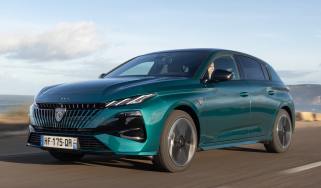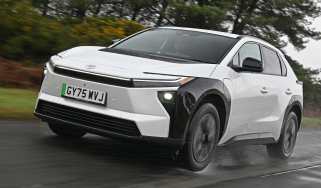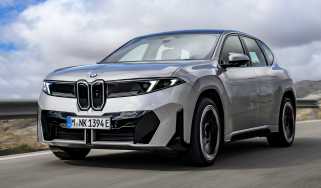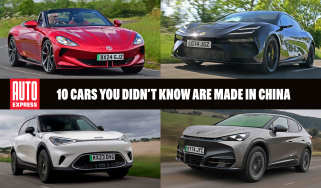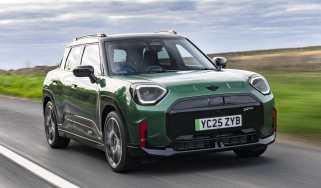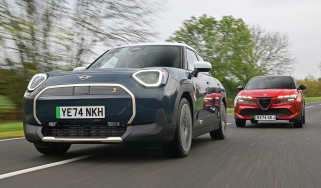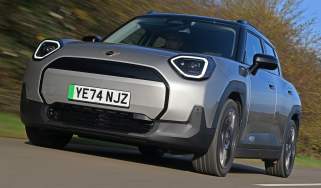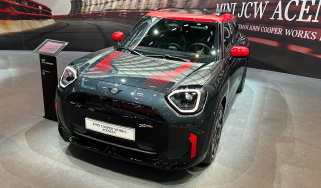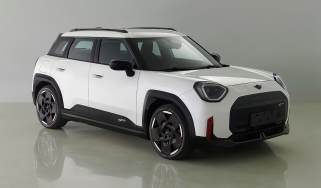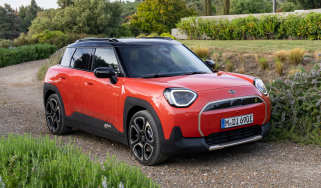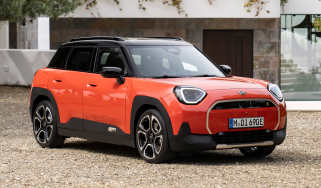MINI Aceman review
Nippy, classy, and stylish, the MINI Aceman is a more versatile electric Cooper, but isn't a spacious family car

Our opinion on the MINI Aceman
The MINI Aceman is a talented small SUV and has plenty of personality to set it apart from the competition. It looks funky, drives brilliantly, and in SE guise, offers a usable 200-plus miles of range. The classy, uniquely styled and beautifully built cabin sets a high-class benchmark, too. But it’s far from perfect, because the interior packaging is poor, and the ride is typically firm – just as it is in all modern MINIs – and we think it could charge slightly faster, too.
About the MINI Aceman
MINI’s ever-expanding product line-up is almost complete. The Aceman slots into the range between the entry-level three-door MINI Cooper and the larger MINI Countryman SUV. Only available as an electric car, you can think of it as a zero-emissions alternative to the five-door hatch.
With prices starting at around £29,000, the MINI Aceman probably can’t be considered a bargain. But take into account a price premium of around £2,000 versus the equivalent three-door, and this small electric SUV starts to look like a better-value proposition.
For your money, you get an extra pair of doors, a more accessible cabin and a slightly bigger boot. This isn’t a large car; space is at a premium anywhere but up front, so it would probably suit those looking for occasional rear seats or the ability to put small kids in the back. People may complain that the Countryman has grown beyond recognition, but the Aceman remains a MINI through and through.
There are two core models to choose from, the latter of which brings a bigger battery for more range; the basic Aceman E uses a 42.5kWh battery for up to 192 miles on a charge, while the Aceman SE ups this to 54.2kWh, boosting the official range to 251 miles.
MINI Aceman prices and latest deals
The Aceman is available in two different battery sizes and three performance levels. Complicating matters is that Aceman E and Aceman SE models can be configured in Classic, Exclusive, or Sport trims, while the top-of-the-range John Cooper Works comes exclusively in Sport trim.
- Aceman E Classic (from £29,000)
- Aceman SE Classic (from £32,000)
- Aceman John Cooper Works Sport (from £37,000)
If you're interested in purchasing an Aceman, our Buy A Car service lets you spec your ideal MINI Aceman and choose the best offer from top dealers around the UK. Alternatively, you can lease an Aceman or buy a used Aceman. We can also help you sell your old car, too.
Engines, performance & drive
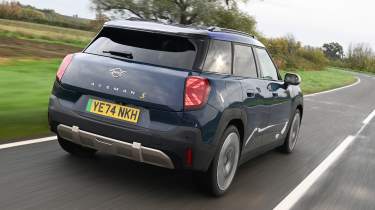
Pros |
|
Cons |
|
You’ll immediately notice a firm edge to the ride and handling of the Aceman, even within the first few hundred yards. This gives an initial impression that the Aceman is as sharp as anything in this class, even including the petrol-powered Ford Puma. However, ask for it to make a quick change of direction, and you'll notice the weight of the Aceman blunts this early feeling of deft handling.
The Aceman has almost too many drive modes to mention, but you’ll rarely need to delve deeper than the usual Core, Green and Go Kart settings – the latter replicating a traditional ‘sport’ mode. Which you choose has an effect on a number of parameters – from motor response to steering weight, as well as the sound the car makes. The raciest of these isn’t what you’d call conventional; the almost sci-fi-like sound crescendos in a pleasing enough way, and changes tone if you push the accelerator pedal past a certain point. It doesn’t attempt to replicate an old-school petrol engine like the Abarth 500e does, but it still offers a level of engagement missing in many rivals.
Elsewhere, there’s a heft to the steering that you’ll not find in any of this car’s Stellantis (Jeep, Alfa Romeo, Peugeot, Vauxhall, Citroen) competitors. Turn in is sharp, and there’s loads of grip – despite a slight tendency for torque steer if you ask for full power from the start.
Comfort is a bit of an issue, in our opinion. The ride felt firm on European roads, with the car constantly bobbing around – even on seemingly smooth tarmac. With our imperfect road surface quality, the Aceman can at times have a rather harsh ride, so we’d encourage you to try a car before signing on the dotted line to find out if you can live with such an unforgiving ride on a daily basis. There’s a little wind noise at motorway speeds, but no worse than rivals’.
Performance, 0-60mph acceleration and top speed
Kicking things off is the Aceman E, and it's certainly no slouch with 181bhp and 290Nm. In our experience, it picks up instantly, with a strong surge of power all the way up to our national speed limit; 0-62mph takes only 7.9 seconds.
The Aceman SE offers plenty of power through the ‘rev’ range. It’ll do 0-62mph in just 7.1 seconds, and we can’t see many needing to step up to the full-fat JCW. If you do, though, it'll trim this time even further to 6.4 seconds if you utilise the 'Boost' paddle behind the steering wheel, unlocking the full 254bhp. Most of the time, the Aceman JCW produces 227bhp.
| Model | Power | 0-60mph | Top speed |
| E 42.5kWh | 181bhp | 7.9 seconds | 99mph |
| SE 54.2kWh | 215bhp | 7.1 seconds | 105mph |
| JCW 54.2kWh | 227bhp (254bhp in Boost mode) | 6.4 seconds | 124mph |
Range, charging & running costs
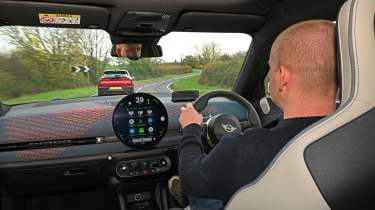
Pros |
|
Cons |
|
All Acemans use a single electric motor mounted to the front axle, with the base ‘E’ model featuring a 42.5Wh battery for up to 192 miles of range, while the punchier ‘SE’ and John Cooper Works models feature a more powerful motor and a larger capacity 54.2kWh battery, and do 251 and 221 miles to a charge, respectively.
During our testing of an Aceman SE, we managed around 3.8mi/kWh on our mixed test route in cool autumn temperatures of around 10-12 degrees, translating to 187 miles to a charge based on the usable capacity of 49.2kWh. That's okay for mostly urban driving, but if you want to go further, either the 355-mile Skoda Elroq with a 77kWh battery or the Kia EV3 with an 81.4kWh battery and 375 miles of range would be better bets.
Whichever Aceman you go for, you get a mediocre peak charging speed. Entry-level 'E' models peak at just 70kWs, while 'SE' and John Cooper Works models have a peak charging speed of 95kW. While that might have been a stand-out feature five years ago, it’s nothing to write home about today; the Jeep, Peugeot, etc, all manage 100kW, while a Volkswagen ID.3 can do 145kW or more.
Those speeds should allow the MINI to recharge from 10-80 per cent in around half an hour, with the bigger-battery car taking slightly longer. Utilise a typical 7.4kW home wallbox charger, and it'll take around seven hours to fully recharge the 42.5kWh battery Aceman from empty, or nine hours to do the same with the 54.2kWh model.
Residual values for the Aceman are decent for the class. Our expert data suggests that the Aceman range is expected to maintain between 48 to 53 per cent of its original value after three years or 36,000 miles – the same as a Volvo EX30.
Insurance costs should be reasonable, because the range starts in group 20 for the 'E' version, goes up to 23 for the quicker 'SE', while the quickest John Cooper Works is in group 29. All those are lower than the Volvo EX30, which starts in group 35.
Like every new electric car, you'll need to pay the standard annual rate of vehicle excise duty (VED), because EVs are no longer exempt from being charged road tax. Most of the Aceman range costs less than £40,000 and, therefore, avoids the luxury car tax surcharge. You'll need to avoid some of the pricier options in order to keep higher trim models below this level, though. The Aceman should be a good company car choice, because all are in the low three per cent benefit in kind (BiK) tax band.
To get an accurate valuation for a specific MINI Aceman, check out our free car valuation tool...
| Model | Battery size | Range | Insurance group |
| E | 42.5kWh (38.5kWh usable) | 191 miles | 20 |
| SE | 54.2kWh (49.2kWh usable) | 251 miles | 23 |
| JCW | 54.2kWh (49.2kWh usable) | 221 miles | 29 |
Design, interior & technology
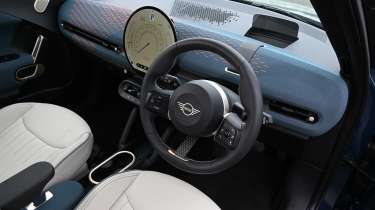
Pros |
|
Cons |
|
The MINI Aceman’s interior will feel familiar to anyone who has sat in the latest MINI Cooper hatchback or Countryman SUV. It really does set the benchmark for small-car cabins, with first-rate material quality, design and layout.
Some may lament the lack of a proper instrument cluster, a head-up display – so you’re not forced to glance at the central screen to view your speed or trip information – is an option as part of the 'Level 1' pack. It feels pretty natural to use and gets a big thumbs-up from us.
Base models are badged Classic and feature LED lights front and rear, roof rails, and 17-inch wheels made from 30 per cent recycled aluminium. Inside, there’s a big circular touchscreen with sat-nav, Apple CarPlay and Android Auto smartphone connectivity, plus dual-zone climate control and a long list of driver-assistance systems.
Upgrade to Exclusive and you get – as the name suggests – a slightly more exclusive look with bigger wheels and a ‘Vibrant Silver’ grille. There are also different roof options, plus a wider paint palette, and different interior trim.
Above this sits the raciest-looking Sport trim, which doesn't look all that different from the JCW model. It boasts a subtle bodykit, some JCW badges, different wheels, body stripes, standard Chili Red paint with a contrast black roof, and a rear spoiler.
Then, on top of this, MINI offers different optional equipment packs. The ‘Level 1’ pack (£2,000 on all 'E' models, standard on all 'SE' and JCW models) adds a head-up display (useful when there's no conventional instrument cluster), wireless phone charging and heated front seats. Next up, ‘Level 2’ (£4,000 on all 'E' models, £2,000 on 'SE', and £1,300 on JCW) brings a panoramic roof, tinted windows and a Harmon Kardon stereo. Finally, ‘Level 3’ (£4,500 on 'SE' Exclusive and Sport models, £3,800 on JCW) throws in electrically operated massaging front seats with a memory function, as well as virtual-reality navigation and extra safety features.
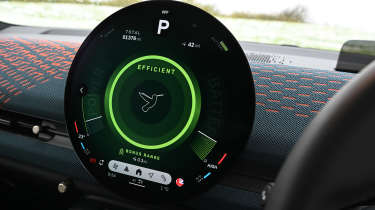
Sat-nav, stereo and infotainment
There’s no arguing that MINI’s latest infotainment system is a bit of a party piece. The big, circular screen in the centre of the dashboard looks great, and it’s responsive enough not to require multiple prods like you might find in some rivals’. Yet we really didn’t find it all that intuitive to operate; sure, you might get used to the layouts, but setting a destination, changing the radio station, and making small adjustments to the climate control temperature should be simpler.
That said, it’s full of functionality, and as always, the fitment of Apple CarPlay and Android Auto means you can bypass many of the tricky submenus if you’re happy to use your phone’s apps instead. It’s a shame it doesn’t fill the entire screen, but this isn’t an issue exclusive to MINI – and a challenge only made harder by the shape of the Aceman’s circular screen.
Boot space, comfort & practicality
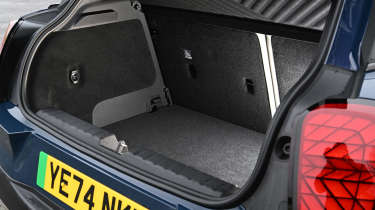
Pros |
|
Cons |
|
You might look at the MINI Aceman and be attracted by its elevated ride height and superior size – at least versus the three-door Cooper – but in reality, this is still a small car.
A six-foot-tall adult can just about squeeze into the back, but it remarkably has less leg room compared with the shorter Renault 5, according to our measurements, and you can forget about fitting three abreast for anything more than a short hop to the shops.
Space in the front is plentiful, although it is a shame that lumbar adjustment isn't standard, and only becomes available if you specify the expensive 'Level 3' pack with full electric front seat adjustment. We're also not fans of the awkward to get to central cubby, which is accessed by pulling on a red nylon strap and is hinged towards the passenger, which doesn't work all that well for a right-hand drive seating position.
Ultimately, think of the Aceman as an electric alternative to the five-door MINI Cooper, and you’ll not be disappointed. However, rivals like the Jeep Avenger, Ford Puma Gen-E, and Skoda Elroq are bigger and much more practical cars.
Dimensions and size
Measuring a fraction over four metres long, the benefit of the Aceman's diminutive size is that it’s perfectly at home in the city, where it can squeeze into tight gaps and parking spots that the larger Countryman cannot. The Aceman is 50mm taller than the regular MINI Cooper, but that doesn't translate into a commanding SUV driving position. Anyone looking for that would be better off with the 1,552mm tall Renault 4 or 1,625mm tall Skoda Elroq.
| Dimensions | |
| Length | 4,079mm |
| Width | 1,754mm |
| Height | 1,514mm |
| Number of seats | Five |
| Boot space | 300/1,005 litres |
Boot space
The trade-off for the compact exterior of the Aceman is a small 300-litre boot – we fitted two carry-on suitcases behind the rear seats, but a bulky buggy or child’s bike might be a stretch. The back seats fold in a typical 60/40 split to reveal a 1,005 litre space, but that's some way short of the 1,283 litres offered by the Puma Gen-E or the 1,580 litres of an Elroq. There's also no clever underfloor storage well like in the Puma, which has a plug at the bottom so you can easily wash it out after storing dirty charging cables or muddy boots.
"I noticed that if you use the rear screen wash to clean the window and then go to get something out of the boot shortly after, all the residual water is able to dribble down in an unsightly mess over the inside trim on the tailgate. I've not come across that on any other car, so it stood out for me when I tested the MINI Aceman." – Max Adams, online reviews editor
Safety & reliability
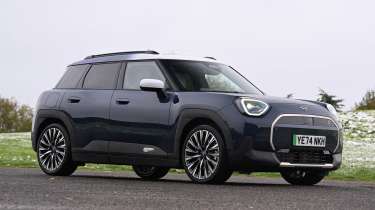
Pros |
|
Cons |
|
The MINI brand finished 22nd (out of 31 manufacturers) in our most recent Driver Power owner satisfaction survey. That’s not a particularly pleasing result, but it does place it above the likes of Cupra (28th), VW (27th) and Ford (23rd), but behind the likes of Volvo (13th), Skoda (12th), and BMW (8th).
In terms of safety, the Aceman gained the maximum five-star rating from safety experts Euro NCAP, along with its smaller MINI Cooper sibling. That's on par with the Smart #3 and BYD Dolphin, and one star ahead of the four-star Renault 4.
There are plenty of driver-assistance systems provided as standard, including speed limit recognition software, lane keep assistance, rear cross traffic alert to warn you of cars crossing your path when reversing out of a parking space, and a blind spot monitoring system to warn you of vehicles alongside you when you go to change lanes.
| Euro NCAP safety ratings |
|
Buying and owning
Best buy: MINI Aceman SE Classic
While the entry-level 'E' would save those only looking for something to drive around town some money, we think the larger battery of the 'SE' makes more sense for its more usable electric driving range and quicker peak charging speed. You also get more kit for your money with 'SE' because that gets our preferred Level 1 pack as standard, which would be an expensive option on an 'E' model. That makes the price difference between an Aceman E Classic (Level 1) and our recommended Aceman SE Classic only £1,000.
Sticking with the Classic trim means you get smaller wheels compared with Exclusive and Sport trims, which can only help with the Aceman's very firm ride.
MINI Aceman alternatives
This part of the market is awash with talented alternatives to the MINI Aceman. It’s impossible to ignore the range of Stellantis small cars, which includes the Jeep Avenger, Alfa Romeo Junior and Peugeot E-2008, as well as the less premium-feeling Vauxhall Mokka and Citroen e-C4.
Then there’s the Volvo EX30, plus the larger Honda e:Ny1, BMW iX1 and Mercedes EQA. You’d be unwise to dismiss the Hyundai Kona Electric, Kia EV3, and Skoda Elroq, too, while the Ford Puma Gen-E is far more practical and charges faster than the Aceman, despite costing significantly less (no doubt helped because it qualifies for the highest electric car grant discount).
If you’d prefer petrol power, then the B-segment isn’t short of compelling cars, the best of which include the Renault Captur, as well as mild and full-hybrid versions of the Kona and Puma.
Deals on the MINI Aceman and alternatives
Frequently Asked Questions
The MINI Aceman gets a three-year, unlimited-mileage warranty, which is about average in this class.

